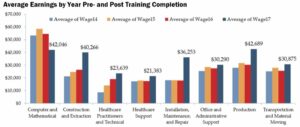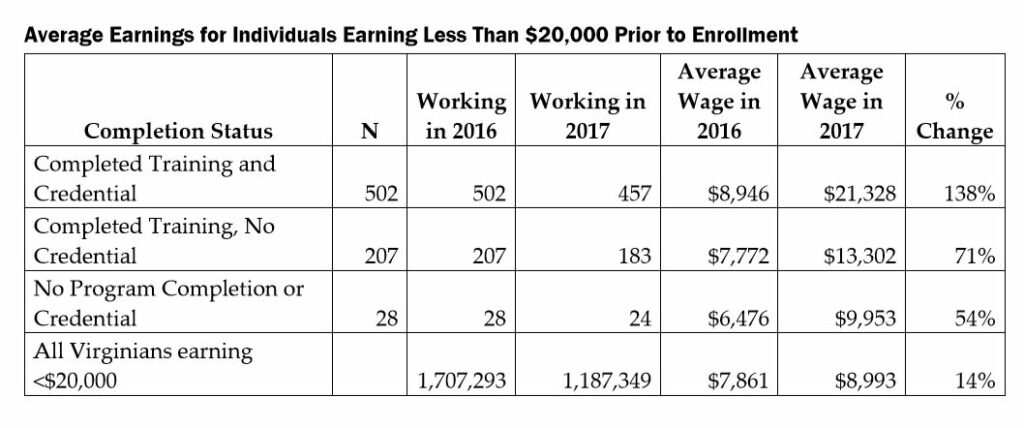
Virginia’s FastForward workforce credential program now in its third year is showing good success in getting students through training, but a high number of people in some programs do not earn the matching certificate. Those who achieve both usually show the highest wage growth.
For those who went into the program earning under $20,000 a year, the subsequent increase in earnings is dramatic, almost 140 percent year over year. “We are serving a very high need population, even compared to the traditional community college population,” said Lori Dwyer, assistant vice chancellor for programs for the Virginia Community College System.
The State Council of Higher Education for Virginia released a detailed report on the program last month. The General Assembly expressed its continued support in a tangible way, agreeing to increase the base funding for next year more than 40 percent to $13.5 million. It also added $1 million to need-based financial aid to help students struggling to cover their one-third cost share.

These certificates or licenses are a recognized credential between the high school diploma and an associate degree, and in the right fields are that ticket to better jobs and wages. Less than three years ago the state started offering students a chance to earn them with the state covering two-thirds of the cost, working though Virginia’s 23 community colleges. Previously financial aid was limited to degree programs. The certificate programs are chosen with employer input.
VCCS is marketing this as FastForward, but it is also described as the New Economy Workforce Credential Grants. Demand was so high enrollment for the 2018-19 term was closed by November. VCCS has been pushing for rapid growth, but SCHEV is going a bit slower and watching the data.
“We will see how next year goes,” was Wendy Kang’s response when asked the ultimate size expected. Kang is director for innovation and finance policy at SCHEV. Enrollment grew to 3,760 this third year, with 3,457 finishing the class and 2,518 earning a credential. The three-year total enrollment has exceeded 8,100. Dwyer has been with the program since the start but admits being surprised “by the degree of the pent-up demand.”
The most popular program trains people for the commercial driver’s license needed to operate tractor-trailer rigs, and of the 1,098 students enrolled last year over 92 percent completed the class and 80 percent earned the license, in that case an absolute requirement for the jobs. The program costs the students an average of $1,448 and the state paid an average of $2,878 for each new licensee.
In the category of computer and mathematical, of the 378 enrolled there were 350 course completions (93 percent) but only 102 credentials obtained (27 percent.) Of 146 enrolled in the CompTIA A+ course, 132 passed but only 22 earned the credential. Of 60 in the network class, 56 passed but only 11 earned the credential.
Low credential attainment also showed up in some of the healthcare fields and administrative and office support. Three medical jobs are on the top-ten list for number of credentials: medical assistant, phlebotomy technician (ouch) and certified nurse aide. But another one where students were struggling with the certificate was pharmacy technician, where 77 of 79 passed the course but only 24 got the license.
The schools usually don’t offer the test for the credential or license, and in some cases may not have been notified when someone passes. Their full reimbursement depends on that information, however, so there is incentive to find out.
Dwyer said VCCS is excited to be getting the kind of data it needs to adjust the programs and improve success. These are open enrollment programs with no pre-admission screening, Dwyer said, so “students come to that who do not have IT backgrounds.” Going forward there will be some evaluation as new students enter to target more support for students who need it.
Tracking the earnings of a set of graduates for three years before they took the classes and then immediately after, the earnings of the computer skills graduates dropped. It happened only in that program. This may also reflect the higher percentage of them not earning the certificate. The data do show those students were already earning a higher average wage when they signed up.
The absence of any of the computer certifications on the list of the ten most-granted stands out, not that Virginia doesn’t also need welders and manufacturing technicians. Virginia wisely is tracking certificate production just as closely as associate’s, bachelor’s and graduate degrees, and not everybody hired by technology giants such as Amazon will need a college degree. Annual production of these certificates in the scores or low hundreds is not going to be enough in the long run.
The 283 enrollees at Northern Virginia Community College was small given the relative size of that school. Two Richmond-area schools working together had almost 500 enrolled in 2018, while the enrollment in Danville, with its high regional unemployment, was 18. Jeff Kraus, VCCS vice chancellor for strategic communications, said that reflects individual school choices, but noted seven presidencies are open and workforce training is being stressed in the search process.
There is financial risk for the individual schools. If all goes as planned, the student pays one-third and the state two-thirds of the cost, leaving no cost to the school. If the student passes the class but earns no certificate, or misses both marks, there is no reimbursement from the state pot of funding for one-third of the program cost. Whether that is holding some schools back is another question the state needs to address.

Leave a Reply
You must be logged in to post a comment.